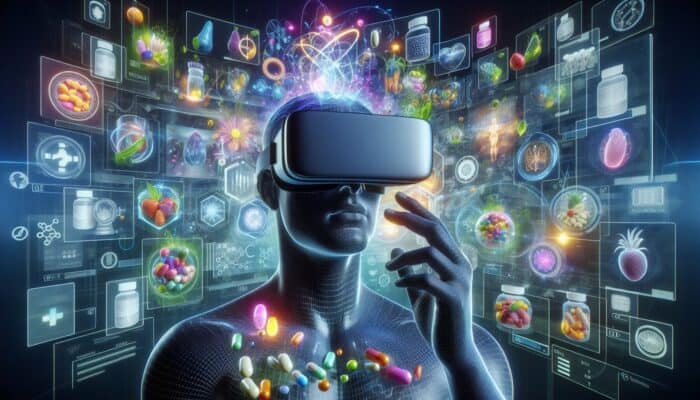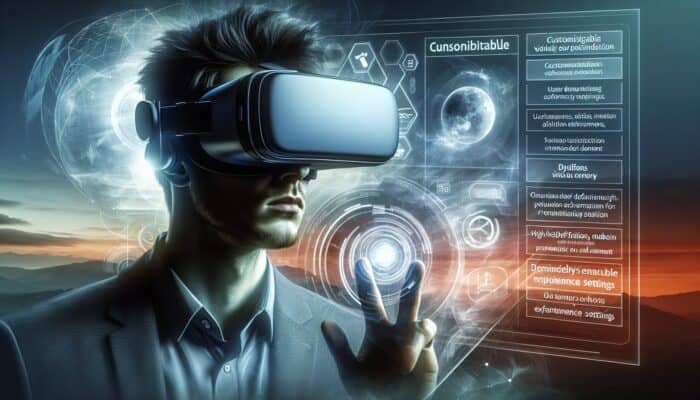
Creating VR Experiences for Supplement Branding
Unlocking the Power of Virtual Reality in Supplement Branding
What Is Virtual Reality and Why Is It Crucial for the Supplement Industry?

Virtual Reality (VR) creates an immersive, interactive digital landscape that allows users to engage deeply with brands. For the supplement industry, VR is especially relevant as it opens up innovative avenues for product education and marketing that resonate with health-conscious consumers. By embracing VR technology, brands can vividly illustrate how their products contribute to improved health and wellness in a manner that captivates audiences. The standout features of VR that cater specifically to the supplement sector include:
- Immersive Experiences: Users can navigate and explore products within dynamic 3D environments.
- Interactive Learning: Consumers engage with educational content that informs their purchasing decisions.
- Realistic Simulations: The potential benefits of supplements can be illustrated through engaging simulations.
- Enhanced Engagement: Captivating VR experiences significantly boost brand recall and recognition.
- Personalized Interactions: Users can customize their VR experiences according to personal preferences.
Integrating VR into supplement branding not only elevates the consumer experience but also aligns with the rising demand for cutting-edge marketing strategies in a competitive marketplace.
What Advantages Does VR Offer for Supplement Branding?
Incorporating VR into supplement branding offers a multitude of advantages that resonate with the expectations of today’s consumers. One of the primary benefits is the potential for heightened customer engagement. The immersive nature of VR creates captivating environments where consumers can interact with products, fostering deeper emotional connections with brands. Additionally, VR serves as a powerful tool for conveying educational information about product benefits, which cultivates a well-informed customer base. The essential benefits of integrating VR into supplement branding are as follows:
- Increased Customer Engagement: Enhanced interactions lead to a stronger attachment to the brand.
- Educational Opportunities: Consumers gain valuable insights about products through engaging and interactive formats.
- Memorable Experiences: Unique VR encounters lead to lasting impressions on consumers.
- Greater Brand Loyalty: Engaging VR environments foster trust and build long-term relationships.
- Boosted Sales: Consumers who engage with VR experiences are more likely to make purchases.
Overall, VR presents brands with a distinctive opportunity to differentiate themselves and connect with their target audiences more profoundly, subsequently leading to increased sales and enhanced customer retention.
How to Effectively Integrate VR into Your Marketing Strategy?
Successfully integrating VR into existing marketing strategies entails a well-structured approach to ensure smooth implementation. The initial step involves evaluating current marketing efforts to identify areas where VR can enhance engagement and interactivity. This evaluation may include a thorough analysis of digital platforms, social media channels, and existing content strategies. The subsequent phases involve pinpointing opportunities for VR adoption, such as virtual product tours or interactive educational sessions. The following steps outline how to seamlessly integrate VR into marketing strategies:
- Assess Current Strategies: Analyze existing marketing initiatives to identify opportunities for VR integration.
- Identify VR Opportunities: Determine specific areas where VR can elevate current marketing campaigns.
- Develop a VR Plan: Create a comprehensive strategy outlining the implementation process.
- Test and Optimize: Execute pilot VR campaigns and evaluate results for continuous improvement.
By embracing this structured methodology, brands can ensure that VR serves as a complementary asset to their existing marketing strategies, thereby enhancing overall effectiveness.
What Are Some Successful Case Studies of VR in Supplement Branding?

Numerous brands have adeptly utilized VR to amplify their supplement marketing initiatives, showcasing the effectiveness of immersive technology. For instance, a leading sports nutrition brand introduced a VR experience that allowed users to explore the scientific principles behind their protein products. This innovative approach not only educated users about the benefits of protein but also engaged them in an interactive setting, significantly elevating brand awareness. Key takeaways from successful VR implementations include:
- Creative Storytelling: Engaging narratives serve to enhance user connection with the brand.
- Interactive Simulations: Users value hands-on experiences that demonstrate product effectiveness.
- Emotional Engagement: VR fosters emotional bonds that traditional advertising often fails to achieve.
- Increased Reach: Innovative strategies attract diverse demographics.
These case studies illustrate that, when executed thoughtfully, VR can significantly transform a brand’s marketing initiatives, resulting in improved customer engagement and loyalty.
Expert Strategies for Crafting Compelling VR Experiences in Supplement Branding
How Does VR Elevate Customer Engagement?
VR enhances customer engagement by immersing users in environments that allow for unprecedented interaction with products. This level of interactivity transcends conventional advertising methods, enabling brands to forge meaningful connections with their audience. For supplement brands, engaging customers through VR can involve a variety of interactive features, such as virtual ingredient sourcing tours or immersive experiences demonstrating the health impacts of products. Here are actionable steps to enhance customer engagement using VR:
- Create Immersive Worlds: Design environments that allow users to fully engage with your brand narrative.
- Interactive Features: Incorporate quizzes, games, or challenges that educate users about the supplements.
- User Feedback Integration: Facilitate user feedback on their experience to drive continuous improvements.
- Social Sharing Options: Encourage users to share their VR experiences on social platforms to broaden reach.
Implementing these strategies can significantly enhance customer engagement, fostering brand loyalty as users are more likely to share their unique experiences with friends and family.
What Are the Essential Best Practices for Creating VR Content?

Crafting engaging VR content is vital for ensuring a positive user experience and maximizing the impact of this immersive technology. Best practices for VR content creation should prioritize quality and user comfort. High-definition visuals are essential for creating a realistic VR environment; pixelated images can detract from the experience and lead to user disengagement. Additionally, implementing user comfort measures, such as adjustable sensitivity settings, can help alleviate motion sickness. Expert recommendations for best practices in VR content creation include:
- High-Quality Visuals: Invest in superior graphics and design to create an immersive setting.
- User Comfort: Design experiences that minimize discomfort, such as preventing motion sickness.
- Interactive Elements: Integrate features that promote user engagement and exploration.
- Clear Narratives: Ensure the VR experience has a coherent narrative that guides users through their journey.
By adhering to these best practices, brands can produce VR content that captivates users and effectively communicates their messaging.
How to Evaluate the Effectiveness of VR Campaigns?
Evaluating the success of VR campaigns involves examining various engagement metrics, conversion rates, and user feedback to gauge effectiveness. Metrics such as session duration can indicate how engaging the experience is, while conversion rates reveal how many users proceed to make a purchase after interacting with the VR content. Real-world examples of assessing VR campaign success include monitoring user interactions within the experience or gathering surveys post-experience for qualitative feedback. Key methods for measuring the success of VR campaigns include:
- Engagement Metrics: Analyze the duration users spend in the VR experience and their interaction rates.
- Conversion Rates: Track how many users make purchases after their VR experience.
- User Feedback: Collect qualitative data through surveys and interviews to understand user sentiments.
- Social Media Analytics: Monitor mentions and shares of the VR experience on social platforms.
By implementing these measurement strategies, brands can gain valuable insights into the effectiveness of their VR marketing strategies, enabling data-driven enhancements for future campaigns.
How Can VR Be Seamlessly Incorporated into Existing Marketing Strategies?
Incorporating VR into existing marketing strategies provides a fresh perspective on brand storytelling and customer interaction. This integration can significantly enhance traditional marketing efforts by introducing a layer of interactivity and immersion that captivates consumers. Brands can utilize several methods to effectively incorporate VR, such as implementing VR content in social media campaigns or enhancing event marketing with interactive VR experiences. Strategies for integrating VR into current campaigns include:
- Aligning with Brand Messaging: Ensure that VR content reinforces the overall narrative of the brand.
- Multi-Channel Integration: Utilize VR across various platforms, including social media, websites, and live events.
- Collaborating with Influencers: Partner with influencers to promote VR experiences and reach new audiences.
- Continuous Content Updates: Regularly refresh VR content to keep users engaged and encourage repeat visits.
By adopting these strategies, brands can leverage VR to enhance their existing marketing tactics, leading to improved consumer engagement and loyalty.
Creating Captivating and Immersive VR Environments
What Key Elements Contribute to an Immersive VR Environment?
An immersive VR environment is defined by several critical elements that collectively create a believable and engaging experience. Realistic graphics are fundamental in drawing users into the environment, while interactive features empower them to actively manipulate and explore their surroundings. A cohesive narrative guides users throughout their journey, ensuring they remain engaged and invested. Important components that enhance an immersive VR environment include:
- High-Quality Graphics: Crisp and realistic visuals bolster the believability of the environment.
- Interactive Features: Engage users by allowing them to interact with various objects or characters.
- Spatial Audio: Sound design adds realism and directs users’ focus within the VR space.
- Cohesive Narrative: A compelling story keeps users engaged, encouraging exploration and interaction.
By concentrating on these elements, brands can develop VR experiences that captivate users and leave lasting impressions, ultimately enhancing their branding initiatives.
How to Ensure a Consistent Brand Experience in VR?
Creating a consistent brand experience in VR is vital for ensuring that users can easily identify and connect with a brand throughout their journey. Aligning VR content with the brand’s identity, messaging, and values guarantees a cohesive experience, whether users are interacting with the brand online or within VR. To achieve this, brands should focus on several key strategies, including:
- Consistent Branding: Utilize brand colors, logos, and themes within the VR experience to ensure recognition.
- Messaging Alignment: Ensure that the content reflects the brand’s core values and messaging.
- Cross-Platform Consistency: Maintain a uniform experience across all platforms where the brand engages users.
- User-Centric Design: Prioritize user experience to facilitate satisfaction and engagement.
By implementing these strategies, brands can ensure that their VR experiences not only engage users but also reinforce their brand identity, ultimately driving loyalty and recognition.
What Technical Considerations Are Crucial for VR Development?
Developing high-quality VR experiences necessitates careful consideration of various technical factors to ensure seamless execution. Hardware compatibility is paramount, as the experience must operate smoothly across different devices without performance issues. Clearly defined software requirements are essential to guarantee that the VR content is developed using appropriate tools and technologies. Performance optimization is another critical factor, ensuring that the VR experience runs efficiently without causing user discomfort. Important technical considerations for VR development include:
- Hardware Compatibility: Ensure the VR experience functions across diverse headsets and devices.
- Software Requirements: Utilize the right development tools and frameworks for optimal performance.
- Performance Optimization: Enhance graphics and interactions to minimize lag and improve user comfort.
- Testing and Quality Assurance: Conduct thorough testing to identify and rectify any issues prior to launch.
By focusing on these technical aspects, brands can deliver high-quality VR experiences that align with user expectations and enhance their branding efforts.
The Role of Storytelling and Narrative in VR Branding
How Can Storytelling Elevate Branding in VR?
Storytelling within VR presents significant potential for enhancing branding by fostering emotional connections with users. A thoughtfully crafted narrative can articulate a brand’s values, mission, and product benefits in a manner that resonates deeply with the audience. By immersing users in compelling stories, brands can create unforgettable experiences that leave a lasting impression. The effectiveness of storytelling in VR branding lies in its capacity to engage users emotionally, making them more inclined to forge connections with the brand. Key ways storytelling enhances branding in VR include:
- Emotional Connections: Narratives facilitate emotional engagement, making brands more relatable.
- Value Communication: Stories can effectively convey brand values and missions.
- User Engagement: Immersive storytelling captures users’ attention and keeps them invested.
- Memorable Experiences: Strong narratives create lasting impressions that encourage brand loyalty.
By weaving compelling storytelling into VR experiences, brands can enrich the overall branding narrative, leading to deeper connections with consumers.
What Techniques Foster Effective VR Storytelling?
Effective VR storytelling involves employing various techniques that engage users and maintain their interest throughout the experience. Character development is essential, as relatable characters can draw users into the narrative and evoke empathy. A well-structured plot ensures that the story unfolds logically, maintaining tension and engagement, while interactive elements allow users to influence the narrative’s direction, making them feel like active participants. Important techniques for effective VR storytelling include:
- Character Development: Create relatable characters that resonate with the audience.
- Plot Structure: Ensure the narrative flows logically, with a clear beginning, middle, and end.
- Interactive Elements: Allow users to make choices that impact the story’s outcome.
- Visual and Auditory Cues: Employ sound and visuals to enhance the storytelling experience.
By mastering these storytelling techniques, brands can craft compelling narratives that enrich the user experience and strengthen brand messaging, ultimately driving consumer engagement.
How to Integrate Brand Messages into VR Narratives?
Integrating brand messages into VR narratives is crucial for ensuring that storytelling aligns with branding objectives. This process involves seamlessly weaving product benefits and brand values into the storyline, enabling users to absorb the messaging naturally as they engage with the VR experience. Effective integration can create a seamless connection between the narrative and the brand, making the experience more impactful. Strategies for integrating brand messages into VR narratives include:
- Weaving Product Benefits: Highlight the advantages of supplements organically within the story.
- Aligning with Brand Values: Ensure the narrative reflects the core values and mission of the brand.
- Interactive Messaging: Encourage users to engage with brand messages through choices in the narrative.
- Reinforcing Brand Identity: Utilize consistent visual and auditory brand elements throughout the story.
By effectively incorporating brand messages into VR narratives, brands can enhance their storytelling approach and ensure that users not only enjoy the experience but also absorb essential branding messages.
Encouraging User Interaction and Engagement in VR
How to Design Interactive VR Experiences for Maximum Engagement?
Designing interactive VR experiences necessitates a thoughtful approach centered on user-centric design principles that enhance engagement. A user-friendly interface is essential, as it allows users to navigate the environment intuitively. Incorporating feedback mechanisms enables users to interact with the experience meaningfully, providing immediate responses to their actions. Intuitive controls ensure that users can easily engage with the VR content without frustration. Key strategies for designing interactive VR experiences include:
- User-Friendly Interfaces: Design navigation systems that are intuitive and easy to understand.
- Feedback Mechanisms: Provide instant feedback for user actions to enhance overall engagement.
- Intuitive Controls: Utilize familiar control schemes to minimize the learning curve.
- Encouraging Exploration: Create environments that invite users to discover and interact with elements.
By implementing these strategies, brands can create interactive VR experiences that not only capture attention but also encourage users to participate actively, enhancing their overall engagement with the brand.
What Are the Critical Metrics for Assessing User Engagement in VR?
Identifying key metrics for assessing user engagement in VR is essential for understanding the effectiveness of VR campaigns. Session duration can indicate how captivating the content is, while interaction rates reveal how frequently users engage with various elements within the experience. User retention is another crucial metric, demonstrating how effectively a brand maintains users’ interest over time. Important metrics for assessing user engagement in VR include:
- Session Duration: Measure how long users spend in the VR experience to gauge engagement levels.
- Interaction Rates: Track how often users interact with different elements within the VR environment.
- User Retention: Evaluate how many users return for repeat experiences over time.
- User Feedback: Collect qualitative feedback through surveys to gain insights into user experiences.
By monitoring these metrics, brands can gather valuable insights into user engagement levels and make informed, data-driven decisions to enhance their VR experiences.
What Strategies Can Be Used to Foster User Participation in VR?
Encouraging user participation in VR experiences is vital for maximizing engagement and creating memorable interactions. Employing gamification strategies can be particularly effective, as they introduce game-like elements such as challenges, rewards, and competition, motivating users to engage more actively. Additionally, personalized experiences tailored to users’ preferences can enhance participation by making them feel valued. Strategies for encouraging user participation in VR include:
- Gamification: Integrate challenges and rewards to motivate users to participate actively.
- Personalized Experiences: Tailor the VR content to match individual user preferences and interests.
- Social Sharing Features: Encourage users to share their experiences on social media for increased visibility.
- Community Engagement: Create opportunities for users to interact with others within the VR environment.
By implementing these strategies, brands can cultivate a sense of community and excitement around their VR experiences, leading to increased user participation and engagement.
Research-Based Benefits of Crafting VR Experiences for Supplement Branding
How Does VR Influence Consumer Behavior?
VR has a profound impact on consumer behavior by enhancing product understanding and fostering brand trust. When consumers engage with VR experiences, they gain valuable insights into how products function and their potential benefits. This increased knowledge often translates into enhanced purchase intent, as users feel more informed and confident in their choices. Research demonstrates that immersive experiences can yield better marketing outcomes, as consumers become increasingly receptive to brand messaging. Key impacts of VR on consumer behavior include:
- Enhanced Product Understanding: Users gain clarity on how products function and their advantages.
- Increased Brand Trust: Engaging experiences foster credibility and reliability.
- Boosted Purchase Intent: Informed consumers are more inclined to make purchasing decisions.
- Improved Brand Recall: Memorable experiences facilitate easier brand recognition.
By harnessing the power of VR, brands can create experiences that not only inform but also persuade consumers, enhancing their overall marketing effectiveness.
What Proven Advantages Does VR Offer in Branding?
The proven advantages of VR in branding extend far beyond novelty; they encompass substantial improvements in consumer engagement and loyalty. Studies indicate that brands utilizing VR often experience heightened engagement rates, as users are drawn into immersive environments that captivate their attention. Enhanced brand recall is another significant advantage, as the unique nature of VR experiences makes it easier for consumers to remember brands associated with those experiences. Key advantages of VR in branding include:
- Higher Engagement Rates: Users are more likely to interact with immersive content.
- Improved Brand Recall: Memorable VR experiences assist in brand recognition.
- Increased Customer Loyalty: Engaging experiences nurture deeper connections with brands.
- Enhanced Customer Insights: VR provides valuable data on consumer behaviors and preferences.
By leveraging these advantages, brands can ensure that their VR initiatives leave a lasting impact on their marketing efforts and consumer relationships.
What Case Studies Showcase Successful VR Implementation in Branding?
Numerous brands have effectively leveraged VR to enhance their marketing efforts, demonstrating the efficacy of this innovative technology. For instance, a prominent vitamin manufacturer crafted a VR experience that allowed users to explore the journey of ingredients from source to supplement. This immersive strategy not only educated consumers about the product but also established a sense of transparency and trust. Real-world examples of VR success in branding highlight essential strategies, such as:
- Engaging Narratives: Brands that tell compelling stories can more effectively captivate users.
- Interactive Learning: Providing users with knowledge about products enriches their experience.
- Brand Transparency: Showcasing ingredient sourcing builds trust among consumers.
- Targeted Marketing: VR can be customized for specific demographics to enhance relevance.
These case studies illustrate that when VR is implemented thoughtfully, it can lead to heightened consumer engagement and brand affinity, ultimately driving sales and fostering long-term loyalty.
Addressing Technical Challenges and Solutions in VR Development
What Common Technical Challenges Arise in VR Development?
The development of VR experiences presents a range of common technical challenges that can hinder user satisfaction and engagement. One significant concern is motion sickness, which can occur if VR experiences are not optimized for user comfort. Hardware limitations can also restrict the quality of VR content, as not all devices are capable of supporting high-quality graphics or responsive interactions. Software compatibility poses another challenge, as developers must ensure that VR content operates seamlessly across diverse platforms. Common technical challenges in VR development include:
- Motion Sickness: Users may experience discomfort if the VR environment is poorly designed.
- Hardware Limitations: Not all devices can support complex VR experiences.
- Software Compatibility: Ensuring that content works across multiple platforms is crucial.
- Performance Optimization: Slow load times and lag can discourage users from engaging.
By recognizing these challenges, brands can take proactive measures to address them, ensuring that their VR experiences are comfortable and enjoyable for users.
How to Navigate VR Development Obstacles?
Overcoming challenges in VR development necessitates a multifaceted approach that directly addresses technical obstacles. To mitigate motion sickness, developers can focus on crafting environments that maintain a consistent frame rate and avoid abrupt movements. Choosing appropriate hardware and optimizing performance are also crucial steps; through rigorous testing of VR content on various devices, brands can ensure compatibility and smooth functionality. Strategies for overcoming VR development obstacles include:
- Performance Optimization: Prioritize minimizing load times and ensuring seamless interactions.
- User Comfort Measures: Design experiences that limit sudden movements and rapid transitions.
- Thorough Testing: Conduct extensive testing across multiple devices to identify and rectify issues.
- Continuous Feedback Loops: Leverage user feedback to enhance experiences and address concerns.
By implementing these strategies, brands can develop high-quality VR experiences that are not only engaging but also user-friendly, ultimately enhancing their overall branding efforts.
What Future Trends in VR Technology Will Impact Branding?
The future of VR technology presents exciting possibilities for branding, with several emerging trends poised to shape its evolution. Advancements in hardware, including lighter and more powerful headsets, will enhance user experiences, making VR more accessible to a wider audience. New interaction methods, such as hand tracking and voice commands, will facilitate more intuitive user engagement within VR environments. Furthermore, increased accessibility via mobile VR will allow brands to connect with broader audiences. Key future trends in VR technology for branding include:
- Advancements in Hardware: Improved headsets will enhance comfort and graphics quality.
- New Interaction Methods: Voice and gesture controls will enable seamless user engagement.
- Mobile VR Accessibility: Mobile platforms will expand the reach of VR experiences.
- Integration of AI: AI can tailor VR experiences based on user behavior and preferences.
By staying ahead of these trends, brands can capitalize on the increasing potential of VR within their marketing strategies, ensuring they remain competitive in an ever-evolving landscape.
Marketing Strategies for Promoting VR Experiences
How to Effectively Promote VR Experiences?
Successfully marketing VR experiences requires a strategic approach that targets the right audience while employing compelling visuals. Brands should emphasize generating excitement around their VR offerings through social media campaigns, influencer collaborations, and targeted advertising initiatives. High-quality visuals are crucial for showcasing the immersive aspects of VR, capturing user attention and encouraging engagement. Strategies for effectively marketing VR experiences include:
- Targeting the Right Audience: Identify demographic segments that will benefit most from VR experiences.
- Creating Compelling Visuals: Utilize high-quality graphics to showcase the VR experience effectively.
- Leveraging Social Media: Promote VR experiences on platforms where target audiences actively engage.
- Utilizing Influencer Partnerships: Collaborate with influencers to broaden reach and enhance credibility.
By implementing these strategies, brands can effectively promote their VR experiences, driving awareness and encouraging user participation.
What Are the Most Effective Channels for Promoting VR Content?
Effectively promoting VR content necessitates leveraging the right channels to reach target audiences effectively. Social media platforms like Instagram and Facebook are ideal for showcasing immersive visuals and fostering user engagement. Partnerships with influencers can amplify reach, as these individuals provide authentic testimonials and share their experiences with their followers. Additionally, targeted advertising on digital platforms helps reach specific consumer demographics. The best channels for promoting VR content include:
- Social Media Platforms: Utilize visual-centric platforms to highlight VR experiences.
- Influencer Partnerships: Collaborate with influencers to enhance credibility and expand reach.
- Targeted Ads: Employ digital advertising to reach well-defined audience segments.
- Email Campaigns: Inform existing customers about new VR experiences and updates.
By utilizing these channels effectively, brands can maximize the visibility of their VR content and drive user engagement.
How to Integrate VR into Comprehensive Marketing Campaigns?
Integrating VR into comprehensive marketing campaigns is essential for establishing a cohesive strategy that amplifies overall brand messaging. The key to successful integration lies in aligning VR experiences with additional marketing efforts, such as email campaigns, events, and social media initiatives. This alignment ensures that the VR experience complements existing marketing activities, forging a unified brand message. Strategies for effectively integrating VR into broader marketing campaigns include:
- Aligning with Other Marketing Efforts: Ensure VR content complements traditional marketing channels.
- Event Integration: Utilize VR at events to create unique, immersive experiences for attendees.
- Cross-Promotion: Promote VR content across various platforms to enhance visibility.
- Consistent Messaging: Maintain a unified brand message across all marketing channels.
By effectively integrating VR into comprehensive marketing campaigns, brands can create a more impactful and cohesive marketing strategy that resonates with their target audience.
Measuring and Analyzing the Performance of VR Campaigns
How to Collect Valuable Data from VR Campaigns?
Gathering data from VR campaigns is essential for evaluating performance and making informed decisions for future initiatives. Brands can track user interactions within the VR experience to obtain quantitative data, while surveys and feedback forms provide qualitative insights. Analyzing engagement metrics, such as session duration and interactions, helps brands understand how users are experiencing their VR content. Effective methods for collecting data from VR campaigns include:
- Tracking User Interactions: Use analytics tools to monitor user behavior within the VR experience.
- Gathering Feedback: Conduct surveys and interviews to collect user sentiments following the experience.
- Analyzing Engagement Metrics: Measure session duration and interaction rates for actionable insights.
- Monitoring Social Media Mentions: Track user engagement and sentiment on social platforms.
By employing these methods, brands can gain valuable insights into the effectiveness of their VR campaigns, guiding future improvements.
What Key Performance Indicators Should Be Used for VR?
Key performance indicators (KPIs) for VR campaigns are crucial for evaluating success and informing strategy adjustments. User engagement metrics, such as session duration and interaction rates, provide insights into how effectively users engage with the content. Conversion rates are essential for assessing the impact of VR experiences on sales, while brand awareness metrics help gauge the overall reach of campaigns. Important KPIs for VR campaigns include:
- User Engagement: Track session duration, interactions, and repeat visits to evaluate engagement levels.
- Conversion Rates: Measure the percentage of users who make purchases following their VR experience.
- Brand Awareness: Utilize surveys and social media metrics to assess the campaign’s reach.
- User Feedback: Gather qualitative data to understand user perceptions and experiences.
By monitoring these KPIs, brands can effectively evaluate the success of their VR campaigns and make informed decisions for future initiatives.
How to Utilize Analytics to Enhance Future VR Campaigns?
Leveraging analytics is vital for refining and optimizing future VR campaigns. By analyzing user data, brands can identify trends, comprehend user behavior, and pinpoint areas for improvement. This data-driven approach facilitates better-targeted campaigns that resonate with audiences. Continuous optimization based on analytics can help brands create more engaging and effective VR experiences over time. Strategies for using analytics to improve future VR campaigns include:
- Identifying Trends: Analyze user data to uncover behavior and preference patterns.
- Understanding User Behavior: Utilize analytics to assess how users interact with VR content.
- Optimizing Content: Adjust VR experiences based on user feedback and performance metrics.
- Segmenting Audiences: Create targeted campaigns based on demographic insights.
By leveraging analytics, brands can enhance the effectiveness of their VR marketing strategies, ensuring a continuous cycle of improvement and increased engagement.
Frequently Asked Questions (FAQs)
What Is Virtual Reality in Supplement Branding?
Virtual Reality, or VR, in supplement branding refers to the utilization of immersive technology to create interactive experiences that engage consumers and educate them about products in memorable ways.
How Does VR Enhance Customer Engagement?
VR boosts customer engagement by providing immersive environments that enable users to interact with products, fostering deeper connections and more meaningful experiences with brands.
What Are the Benefits of Using VR for Branding?
The benefits of using VR for branding encompass increased customer engagement, educational opportunities, memorable experiences, enhanced brand loyalty, and higher sales.
How Can Brands Measure the Success of VR Campaigns?
Brands can assess the success of VR campaigns through engagement metrics, conversion rates, user feedback, and social media interactions to evaluate effectiveness.
What Techniques Improve VR Storytelling?
Enhancing VR storytelling techniques involves character development, structured plots, interactive elements, and effective use of visuals and sound to engage users.
What Are Common Challenges in VR Development?
Common challenges in VR development include motion sickness, hardware limitations, software compatibility issues, and performance optimization, which can impact user experience.
How Can Brands Overcome Obstacles in VR Development?
Brands can navigate VR development obstacles by optimizing performance, ensuring user comfort, conducting thorough testing across devices, and maintaining continuous feedback loops.
What Are the Future Trends in VR Technology for Branding?
Future trends in VR technology for branding encompass advancements in hardware, new interaction methods, increased mobile accessibility, and the integration of AI for personalized experiences.
How Should Brands Market Their VR Experiences?
Brands should effectively market their VR experiences by targeting the right audience, creating compelling visuals, leveraging social media, and utilizing influencer partnerships for greater reach.
What Are Key Performance Indicators for VR Campaigns?
Key performance indicators for VR campaigns include user engagement metrics, conversion rates, brand awareness, and user feedback to assess overall success.
Explore our journey on X!
The Article Creating VR Experiences for Supplement Branding was first published on https://marketing-tutor.com




